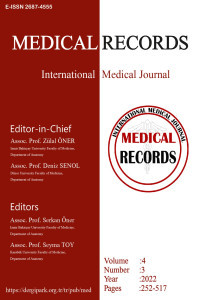Meme Kanseri Hakkında Internet Tabanlı ve Dijital Hikaye Eğitimi Arasındaki Teorik Bilgi Farkı
Theoretical Knowledge Difference Between Internet-Based and Digital Storytelling Education About Breast Cancer
___
- Benner, P. (2012). Educating nurses: A call for radical transformation—how far have we come? . Journal of Nursing Education, 51(4), 183-184. doi:10.3928/01484834-20120402-01
- Car, J., Carlstedt-Duke, J., Car, L. T., Posadzki, P., Whiting, P., & Zary, N. (2019). Digital education in health professions: the need for overarching evidence synthesis. Journal of medical Internet research, 21(2), e12913.
- Chun-Ming, H., Hwang, G.-J., & Huang, I. (2012). A project-based digital storytelling approach for improving students' learning motivation, problem-solving competence and learning achievement. Journal of Educational Technology & Society, 15(4), 368.
- Duman, B., & Göcen, G. J. A. (2015). The effect of the digital storytelling method on pre-service teachers’ creative writing skills. 20(1-2), 215-222.
- Duveskog, M., Tedre, M., Sedano, C. I., Sutinen, E. J. J. o. E. T., & Society. (2012). Life Planning by digital storytelling in a primary school in rural Tanzania. 15(4).
- Evans, C. A. (2016). Learning transfer evidence in baccalaureate senior nursing students using a disaster emergency preparedness tabletop exercise. . Medicine.
- Fiset, V. J., Graham, I. D., & Davies, B. L. (2017). Evidence-Based Practice in Clinical Nursing Education: A Scoping Review. Journal of Nursing Education, 56(9), 534-541.
- Gerdprasert, S., Pruksacheva, T., Panijpan, B., & Ruenwongsa, P. (2011). An interactive webbased learning unit to facilitate and improve intrapartum nursing care of nursing students. . Nurse Educ. Today, 31(5), 531–535 doi:10.1016/j.nedt.2010.10.008
- Günay, U., & Kılınç, G. (2018). The transfer of theoretical knowledge to clinical practice by nursing students and the difficulties they experience: A qualitative study. Nurse education today, 65, 81-86.
- Hall, H., Brosnan, C., Cant, R., Collins, M., & Leach, M. (2018). Nurses’ attitudes and behaviour towards patients’ use of complementary therapies: A mixed methods study. Journal of advanced nursing, 74(7), 1649-1658.
- Hultsjö, S., Bachrach-Lindström, M., Safipour, J., & Hadziabdic, E. (2019). “Cultural awareness requires more than theoretical education”-Nursing students’ experiences. Nurse education in practice, 39, 73-79.
- Kadivar, M., Seyedfatemi, N., Farahani, T. M., Mehran, A., & Pridham, K. F. (2007). Effectiveness of an internet-based education on maternal satisfaction in NICUs. Patient education and counseling, 100(5), 943-949.
- Kearney, M. (2011). A learning design for student‐generated digital storytelling. Learning, Media and Technology, 36(2), 169-188.
- King, E., & Boyatt, R. (2015). Exploring factors that influence adoption of e-learning within higher education. . Br. J. Educ. Technol. , 46, 1272–1280.
- Lu, D. F., Lin, Z. C., & Li, Y. J. (2009). Effects of a web-based course on nursing skills and knowledge learning. . J. Nurs. Educ. , 48 (2), 70–77 doi:10.3928/01484834-20090201-10
- Pearlson, K. E., Saunders, C. S., & Galletta, D. F. (2019). Managing and using information systems: A strategic approach. : John Wiley & Sons.
- Price, D. M., Strodtman, L., Brough, E., Lonn, S., & Luo, A. (2015). Digital storytelling: an innovative technological approach to nursing education. Nurse educator, 40(2), 66-70.
- Shankar, A., Rath, G., Roy, S., Malik, A., Bhandari, R., Kishor, K., . . . Singh, R. (2015). Level of awareness of cervical and breast cancer risk factors and safe practices among college teachers of different states in India: do awareness programmes have an impact on adoption of safe practices. Asian Pac J Cancer Prev, 16(3), 927-932.
- Tatli, Z., Uğur, N., & Çakiroğlu, Ü. (2018). Peer assessment through digital storytelling: experiences of pre-service IT teachers. The International Journal of Information and Learning Technology, 35(3), 217-228.
- Yeh, C. H., Lin, C. Y., Muchtar, K., Lai, H. E., & Sun, M. T. (2017). Three-pronged compensation and hysteresis thresholding for moving object detection in real-time video surveillance. . IEEE Transactions on Industrial Electronics, 64(6), 4945-4955.
- Yüzer, T. V., & Kılınç, A. G. H. (2015). Benefit from the digital storytelling in the open learning system. Journal of Research in Education and Teaching, 4(1): 243-250.
- Zaccagnini, M., & Pechacek, J. M. (2019). The doctor of nursing practice essentials: A new model for advanced practice nursing (Fourth Edition ed.): Jones & Barlett Learning.
- Yayın Aralığı: Yılda 3 Sayı
- Başlangıç: 2019
- Yayıncı: Zülal ÖNER
Çocuklarda On Yıllık Hepatit A, B ve C Seroprevalans Trendi: Tek Merkez Sonuçları
Eren YILDIZ, Mehmet Ali NARSAT
Alper CAGLAYAN, Mustafa Ozan HORSANALI
Covid-19 Tedavisinde Sitokin Filtresi Deneyimi;Tek Merkezli Bir Çalışma
Fovea Capitis Femoris’in Morfometrik ve Morfolojik Değerlendirilmesi
D Vitamini Seviyesi Preeklampsinin Şiddetini Değiştirir mi? Tek Merkezli Vaka Kontrol Çalışması
Duygu DEMİRÖZ ASLAN, Karolin OHANOĞLU, Mediha Kübra CEYLAN, Fatma Ferda VERİT
Asıya Bağlı Uzun Styloid Proçes Kırığı
Turgay BÖRK, Muhammet BATBAŞ, Nazif Harun VİCDANLI, Abdürrahim TÜRKOĞLU
Sümeyye ALTIPARMAK, Sümeyya Betül KIZRAK, Çiğdem KARAKAYALI AY, Yeşim AKSOY DERYA
